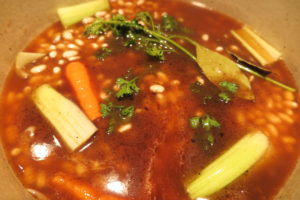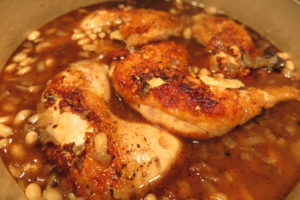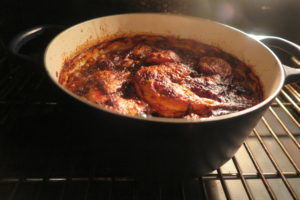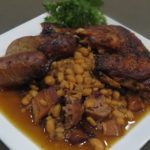Michigan Cassoulet
Traditional French Cassoulet comes from three villages in France (Toulouse, Castelnaudary, and Carcassonne), each village with its own “true” version of the recipe. So, there is much fuss about the “right” way to do it. I’ve never experienced cassoulet right from one these French villages but the cassoulet I have eaten on our home turf of the good old USA has been an absolutely lovely rich combination of meats and beans with simple flavors, a perfect fall entrée.
There are some guidelines I followed so I didn’t just create the most elegant Baked Beans but something as special as a French Cassoulet.
- It’s a peasant dish using locally sourced food.
I bought as many ingredients as possible that were local or from Michigan. - Duck, Partridge, Pheasant, Lamb, Pork, and Sausage – a combination of these meats were used.
Duck, Partridge and Pheasant were easily accessible to the French Villages, not so much for me. I used local Chicken (cooked in duck fat) as my poultry. Instead of a pork sausage, I used duck and lamb sausage. - It was all created in a single pot.
No kitchen sink filled with pots and pans, this was going to work in a single pot. - The casserole formed a dark crust as it slowly cooked. They used a pot with tapered edges, allowing more surface area to brown.
I don’t have that kind of pan. Some people will top the casserole with breadcrumbs to create a crust. That felt like cheating. I read that if you use a home-made chicken stock it will have a higher concentration of gelatin than store bought stock. This thicker stock will help create that crust.
My sincerest apologies to the purest of the Cassoulet world. What I created here was my Michigan version of Cassoulet following the guidelines that felt like the heart and soul of the French Cassoulet. I used as many local and Michigan products as possible. To start with, traditional cassoulet uses lingot (a dried white bean). I used a Michigan navy bean instead. When it came to meat, duck can be expensive so I substituted local whole chicken legs cooked in duck fat. To cover the bases with the pork, I used local bacon. Then to tie everything together instead of using a 100% pork sausage, I used local lamb and duck sausage. So I covered all the meat and kept it local. So like the French peasants who created this dish from locally accessible foods, I did the same. The vegetables are all readily available. Due to the time of year, I can’t claim they are local. But if you were creating this dish during our harvest season, you would be able to use local carrots, onion, celery, garlic and parsley.
The French version of this dish is not a thick stew with beans, meat and vegetables and topped with a crumb crust. It is beans swimming in a rich, gelatinous broth with bits of tender meat. This recipe might not be a perfect reproduction of a French Cassoulet. Food imports so much from where it is made. It is an absolutely lovely version of a Michigan Cassoulet created in our own beautiful spot in the world.
Like most recipes, it is a good idea to get all your ingredients prepped and ready to go. You’ll be cooking with high heat so you want to be able to move from one step to another without having to chop or find the necessary ingredients. In addition, have a long pair of tongs available to keep your hands as far away from the sizzling pot as possible. Use a screen over the pot while you are browning the meats. This is a safe way to keep from getting splattered and helps keep your stovetop clean.
So, let’s begin. The night before you’re going to need to soak your beans. The texture of dried beans is superior to canned beans, making this step very worthwhile.
Michigan Cassoulet
Ingredients
The Day Before
- 1 pound Navy Beans
- 3 quarts Water
- 3 tablespoons Salt
Creating The Cassoulet
- 4 Whole Chicken Legs
- 2 tablespoons Duck Fat
- 1/2 pound Thick Cut Bacon chopped into 1 inch pieces
- 2 Lamb Sausages approximately ½-3/4 pound
- 2 Duck Sausages approximately ½-3/4 pound
- 1 Large Onion finely diced
- 1 Carrot unpeeled and cut into 3 pieces
- 2 Celery Stalk cut into 3 pieces
- 1 cloves Whole Garlic Bulb separateand peel
- 4 sprigs Parsley
- 2 Bay Leaves
Instructions
The Day Before
- Add water and salt to a large bowl. Stir to dissolve the salt. Add the beans and soak overnight. The next day, drain the beans and set to the side.

Creating the Cassoulet
- Preheat oven to 300 degrees.
- Chicken: Melt duck fat in Dutch oven over medium high heat. When melted and starting to sizzle, slowly add the chicken, skin side down. Cover with your screen and allow to cook for 6-7 minutes or until deeply browned. Carefully turn chicken over and cook on the other side for 3 minutes. Set to the side on a platter.
- Bacon: Add chopped bacon to the pot. Cover with your screen and cook for 4 minutes, stirring frequently. Set to the side on the platter with the chicken.
- Sausage: Add the sausage to the pot. Cover with your screen and brown the sausage, turning periodically to brown both sides. This should take about 4 minutes. Set to the side with the chicken and bacon.

- The Vegetables: Drain all but 2 tablespoons of the fat from the pan. Reduce heat to medium. Add the onions, scraping the brown bits on the bottom of the pan. Cook until the onions are translucent, about 4 minutes. Slowly add the stock and continue scraping the brown bits off the bottom of the pan. Add the garlic, parsley, celery, carrot, bay leaves and beans. Stir to incorporate. Increase heat to high and bring to a simmer. Reduce the heat to low and cover the pot. Continue cooking for 45 minutes or until the beans still have a slight bite.

- Putting It All Together: Remove the celery, carrot, parley and bay leaves. Add the sausage and bacon and submerge into the beans. Place the chicken legs on top, skin side up. The beans should be submerged in the stock and the chicken laying on top. Put the Cassoulet into the oven (uncovered) for 2 hours.

- Check to ensure there is enough liquid and the beans are submerged. Add a little water to the edge of the pan if it seems to be a little dry. You don’t want to pour water on top or it will break the crust that’s forming. Cook an additional 3-4 hours, checking periodically and adding water if needed.
- After 5 hours, you can add a little water to the edges and turn your oven down to 150 degrees. You can hold till you’re ready to serve. Periodically check to ensure it doesn’t need a little more water. You don’t want it to dry out.



